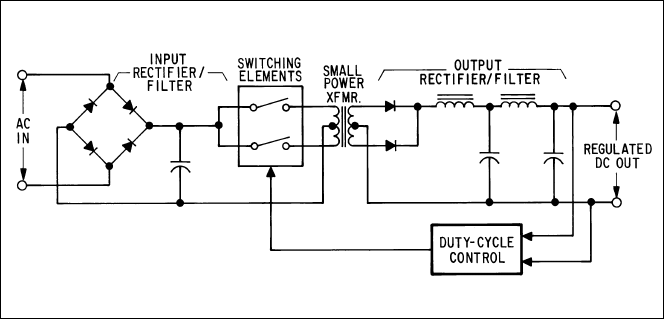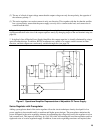
26
switching power transistors, fast recovery diodes, and new filter capacitors with lower series resistance and
inductance, have propelled switching supplies to a position of great prominence in the power supply industry.
Presently, switching supplies still have a strong growth potential and are constantly changing as better
components become available and new design techniques emerge. Concurrently, performance is improving,
costs are dropping, and the power level at which switching supplies are competitive with linear supplies
continues to decrease. Before continuing with this discussion, a look at a basic switching supply circuit will
help to explain some of the reasons for its popularity.
Basic Switching Supply
In a switching supply, the regulating elements consist of series connected transistors that act as rapidly opened
and closed switches (Figure 9). The input ac is first converted to unregulated dc which, in turn, is "chopped" by
the switching element operating at a rapid rate(typically 20KHz). The resultant 20KHz pulse train is
transformer-coupled to an output network which provides final rectification and smoothing of the dc output.
Regulation is accomplished by control circuits that vary the on-off periods (duty cycle) of the switching
elements if the output voltage attempts to chance.
Figure 9. Basic Switching Supply
Operating Advantages and Disadvantages. Because switching regulators are basically on/off devices, they
avoid the higher power dissipation associated with the rheostat-like action of a series regulator. The switching
transistors dissipate very little power when either saturated (on) or nonconducting (off) and most of the power
losses occur elsewhere in the supply. Efficiencies ranging from 65 to 85% are typical for switching supplies, as
compared to 30 to 45% efficiencies for linear types. With less wasted power, switching supplies run at cooler
temperatures, cost less to operate, and have smaller regulator heat sinks.
Significant size and weight reductions for switching supplies are achieved because of their high switching rate.
The power transformer, inductors, and filter capacitors for 20KHz operation are much smaller and lighter than
those required for operation at power line frequencies. Typically, a switching supply is less than one-third the
size and weight of a comparable series regulated supply.
Besides high efficiency and reduced size and weight, switching supplies have still another benefit that suits the
needs of the modern environment. That is their ability to operate under low ac input voltage (brownout) con-
ditions and a relatively long carryover (or holdup) of their output if input power is lost momentarily. The
switching supply is superior to the linear supply in this regard because more energy can be stored in its input
filter capacitance. To provide the low voltage, high current output required in many of today's applications, the
series regulated supply first steps down the input ac and energy storage must be in a filter capacitor with a low


















